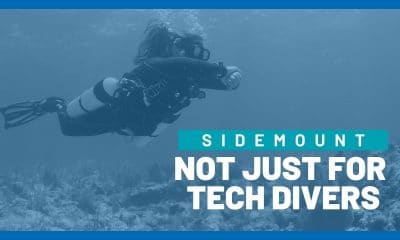Blogs
Myth – Hydration is the most important factor in avoiding DCS

By Mark Powell
The maintenance of a good state of hydration is generally considered to be very important for overall health and dehydration can have significant implications on health and exercise performance. Dehydration has long been considered by many divers to be one of the most significant, or even THE MOST significant, factor in DCS risk other than following correct dive profiles.
The idea that hydration is the most important factor in avoiding DCS has been repeated so often that it is taken as an undisputed fact. Many diving manuals repeat this misconception and there are countless articles online which make the same point.
As we have already seen in this series, just because something is repeated over and over again, does not mean it is a fact and widely believed rules are sometimes found to be based on no evidence at all.
Historically there has been very little research on this point, as it was taken to be self-evidently true by many, although rejected by others. There were only a very small number of studies investigating the topic although in recent years this gap has been slowly been addressed as researchers have tried to prove or disprove the idea.
If we look at the scientific evidence for the impact of hydration on DCS risk we can find one paper from 2007 which showed that diving causes dehydration [1]. Another showed that prehydration resulted in a reduction in bubbling post dive [2] and a third showed a reduction in DCS risk [3] although there were some queries about this study. None of these were conclusive and the reduction in bubbling and DCS risk was not huge. This seemed to imply that the benefits of hydration have been overstated at best and does not have anywhere near the impact that was believed. This is especially true when compared to the impact of other forms of preconditioning such as vibration or sauna or when compared with other factors such as temperature which provided a much bigger change in DCS risk.
However, some more recent papers seem to show that hydration does indeed have an impact on DCS risk although less than many other factors such as temperature and exercise [4].
At the same time that the benefits of hydration were being questioned, the risks of over overhydration were starting to be considered.
In particular, excessive overhydration (hyperhydration) can increase the risk of immersion pulmonary edema. However, in some circles this has been misinterpreted as meaning that a normal level of hydration is bad as it increases the risk of this condition.

MYTH – Hydration increases the risk of IPO/IPE
Immersion pulmonary odema/edema (IPO/IPE) occurs when fluid leaks into the alveoli in the lungs. This results in sudden shortness of breath, cough and sometimes blood-tinged, frothy sputum.
IPO was once considered rare, but is now more widely recognized. While the actual numbers of cases are unknown, it is most likely underdiagnosed. This might be because:
- It is difficult to detect in fatalities.
- It can be mistaken for drowning.
- Mild cases of IPE can resolve spontaneously.
Factors contributing to IPO may include:
- Hydrostatic pressure gradient
- Cold-induced vasoconstriction
- Exertion
- Hydrostatic gradient between mouth and alveoli
- Inspiratory resistance caused by the regulator
- Increased gas density at depth
- Excessive pre-dive hydration
- Hypertension
Many of these factors may be present in adventurous or technical diving. Divers Alert Network (DAN) recommends that you abort the dive as quickly and safely as possible if you experience:
- Sudden shortness of breath.
- Persistent cough.
Upon surfacing breathe 100 percent oxygen and postpone further diving until you can consult a physician.
Although mild cases of IPO can resolve without further treatment once a diver has exited the water, respiratory distress while diving can be extremely dangerous. IPO becomes an even greater concern when you face an extended decompression obligation. Here you must balance the risks of:
- IPE symptoms worsening if you remain under water.
- Suffering DCS if you shorten or skip decompression stops.
You will notice that in the description above, one of the factors contributing to IPO is listed as “Excessive pre-dive hydration”. As mentioned earlier this has, in some circles, been misinterpreted as meaning that hydration is bad as it increases the risk of IPO.
When considering hydration levels, it is important to remember that there are three relative states. Which in layman’s terms we describe as dehydration, proper hydration and excessive overhydration. I have avoided the more scientific terms hypohydration, euhydration and hyperhydration in order to make this explanation more accessible to the non-scientist.
As proof that this myth exists, I have included below an extract from a genuine email I received from one of my students;
“I genuinely believed (I don’t know where I got this from) that if you drink anything before a dive, you’re putting yourself at risk of getting IPO. I didn’t realise the shear amount you actually had to drink to increase that risk. So on occasion I’ve had a tea between dives and then jumped in for a second dive and in the back of my mind be thinking ‘I hope I don’t start coughing uncontrollably now and give myself IPO because of that tea’”
One of the most commonly referenced articles on IPO, and an article that the student above had definitely read, contains the following quote [6] “I am particularly concerned that many divers overhydrate with fluids before a dive, in the belief that it will protect them against decompression illness. The evidence that it protects is not convincing. In contrast there is unequivocal evidence that excessive hydration increases the risk of IPO in both divers and swimmers. Overhydration has an additive effect on the increase in alveolar capillary pressure resulting from immersion. So I strongly advise divers not to overhydrate before diving.”
As you can see this does not state that an extra cup of tea will cause IPO but you can see how a myth could grow from this. It is easy to take the statement “I strongly advise divers not to overhydrate before diving.” and misremember it as “I strongly advise divers not to hydrate before diving.” This advice does not distinguish or give any advice on where is the line between hydration and overhydration? Is that extra cup of tea enough to tip us over the line into overhydration?
To answer the question about the difference between hydration and excessive hydration it worth looking at the article described as ‘unequivocal evidence’ in [5]. This refers to a study carried out on military swimmers.[6] An extract of the study is shown below; “Thirty young men on a military fitness training programme were engaged in a swimming time trial over 2.4 km in the open sea. The sea was calm and the measured water temperature 23°. They swam in the supine position wearing only a bathing suit and using fins. Because of the high heat load expected, the swimmers had been instructed to drink large quantities of water before the swim, to avoid becoming dehydrated. They each drank about five litres of water during the two hours preceding the exercise.”
Five litres (8.8 pints) is a huge volume of water to drink in a two-hour period. For someone who was already well hydrated it could easily put them into a position of hyperhydration. Although it might not be a problem for someone who started out in a dehydrated state. The key point is that there is a big difference between proper hydration and excessive overhydration (hyperhydration). A large glass of water, a 1 litr bottle of water or even a large mug of tea is not excessive overhydration.

Conclusion – Myth or not?
Hydration does indeed seem to be a factor in DCS risk and it seems clear that being properly hydrated is a good thing for health in general and also for diving. Hydration is not be the most important factor in reducing DCS risk but anything that reduces DCS risk at all is a positive thing. Excessive overhydration can increase the risk of IPO but excessive overhydration is not the same as being properly hydrated.
Being properly hydrates gives some advantages in reducing DCS risk and likely does not create undue IPO risk. As in so many areas of life there is a balance. Do not dive while you are excessively dehydrated and do not dive while you are excessively overhydrated. Stick to the Goldilocks zone – not underhydrated, not over hydrated but just right.
How to hydrate

The other conclusion we can draw from this discussion is that educators, scientists, researchers, speakers and writers need to be careful about the impression we create. An article or conference presentation may contain perfectly truthful information but that can be misinterpreted and be seen as promoting a very different conclusion to the one intended. This is exactly how myths develop.
Thank you to Neal Pollock who reviewed several early drafts of this article to ensure that my attempts to explain these concepts in non-scientific language did not lose any of the scientific validity. Any errors or misunderstandings are still down to me.
References
[1] Williams ST, Prior FG, Bryson P. Hematocrit change in tropical scuba divers. Wilderness Environ Med. 2007;18(1):48-53.
[2] Gempp E, Blatteau JE, Pontier J-M, Balestra C, Louge P. Preventive effect of pre-dive hydration on bubble formation in divers. Br. J. Sports Med. 2009;43:224–228.
[3] Fahlman A, Dromsky DM. Dehydration effects on the risk of severe decompression sickness in a swine model. Aviat Space Environ. Med. 2006;77:102–106.
[4] Wang Q, Guerrero F, Theron M. Pre-hydration strongly reduces decompression sickness occurrence after a simulated dive in the rat. Diving Hyperb Med. 2020;50(3):288-291.
[5] https://www.bsac.com/news-and-blog/the-hidden-killer-immersion-pulmonary-oedema-ipo/
[6] Weiler-Ravell D, Shupak A, Goldenberg I, Halpern P, Shoshani O, Hirschhorn G, et al. Pulmonary oedema and haemoptysis induced by strenuous swimming. BMJ. 1995;311:361.
Blogs
Northern Red Sea Reefs and Wrecks Trip Report, Part 3: The Mighty Thistlegorm

Jake Davies boards Ghazala Explorer for an unforgettable Red Sea diving experience…
Overnight, the wind picked up, making the planned morning dive a bit bumpy on the Zodiacs to the drop point on Thomas Reef. There, we would dive along the reef before descending through the canyon and then passing under the arch before ascending the wall with a gentle drift. The site provided great encounters with more pelagic species, including shoals of large barracuda, tuna, and bigeye trevally.
Once back on the boat, it was time to get everything tied down again as we would head back south. This time, with the wind behind us, heading to Ras Mohammed to dive Jackfish Alley for another great gentle drift wall dive before then heading up the coast towards the Gulf of Suez to moor up at the wreck of the Thistlegorm. This being the highlight wreck dive of the trip and for many onboard, including myself, it was the first time diving this iconic wreck. I had heard so much about the wreck from friends, and globally, this is a must on any diver’s list. Fortunately for us, there was only one other boat at the site, which was a rarity. A great briefing was delivered by Ahmed, who provided a detailed background about the wreck’s history along with all the required safety information as the currents and visibility at the site can be variable.

Kitting up, there was a lot of excitement on deck before entering the water and heading down the shoreline. Descending to the wreck, there was a light northerly current which reduced the visibility, making it feel more like the conditions that can be found off the Welsh coast. At 10m from the bottom, the outline of the wreck appeared as we reached the area of the wreck which had been bombed, as our mooring line was attached to part of the propeller shaft. Arriving on deck, instantly everywhere you looked there were many of the supplies which the ship was carrying, including Bren Carrier tanks and projectiles that instantly stood out.

We headed around the exterior, taking a look at the large propeller and guns mounted on deck before entering the wreck on the port side to take a look in the holds. It was incredible to see all the trucks, Norton 16H, and BSA motorcycles still perfectly stacked within, providing a real snapshot in time.

Overall, we had four dives on the Thistlegorm, where for all of the dives we were the only group in the water, and at times, there were just three of us on the whole wreck, which made it even more special, especially knowing that most days the wreck has hundreds of divers. Along with the history of the wreck, there was plenty of marine life on the wreck and around, from big green turtles to batfish, along with shoals of mackerel being hunted by trevally. Some unforgettable dives.

The final leg of the trip saw us cross back over the Suez Canal to the Gobal Islands where we planned to stay the night and do three dives at the Dolphin House for the potential of sharing the dive with dolphins. The site, which included a channel that was teeming with reef fish, especially large numbers of goatfish that swam in large shoals along the edge of the reef. These were nice relaxing dives to end the week. Unfortunately, the dolphins didn’t show up, which was okay as like all marine life they are difficult to predict and you can’t guarantee what’s going to be seen. With the last dive complete, we headed back to port for the final night where it was time to clean all the kit and pack before the departure flight the next day.

The whole week from start to finish on Ghazala Explorer was amazing; the boat had all the facilities you need for a comfortable week aboard. The crew were always there to help throughout the day and the chefs providing top quality food which was required after every dive. The itinerary providing some of the best diving with a nice mixture of wreck and reef dives. I would recommend the trip to anyone, whether it’s your first Red Sea liveaboard in the Red Sea or you’re revisiting. Hopefully, it’s not too long before I head back to explore more of the Red Sea onboard Ghazala Explorer.
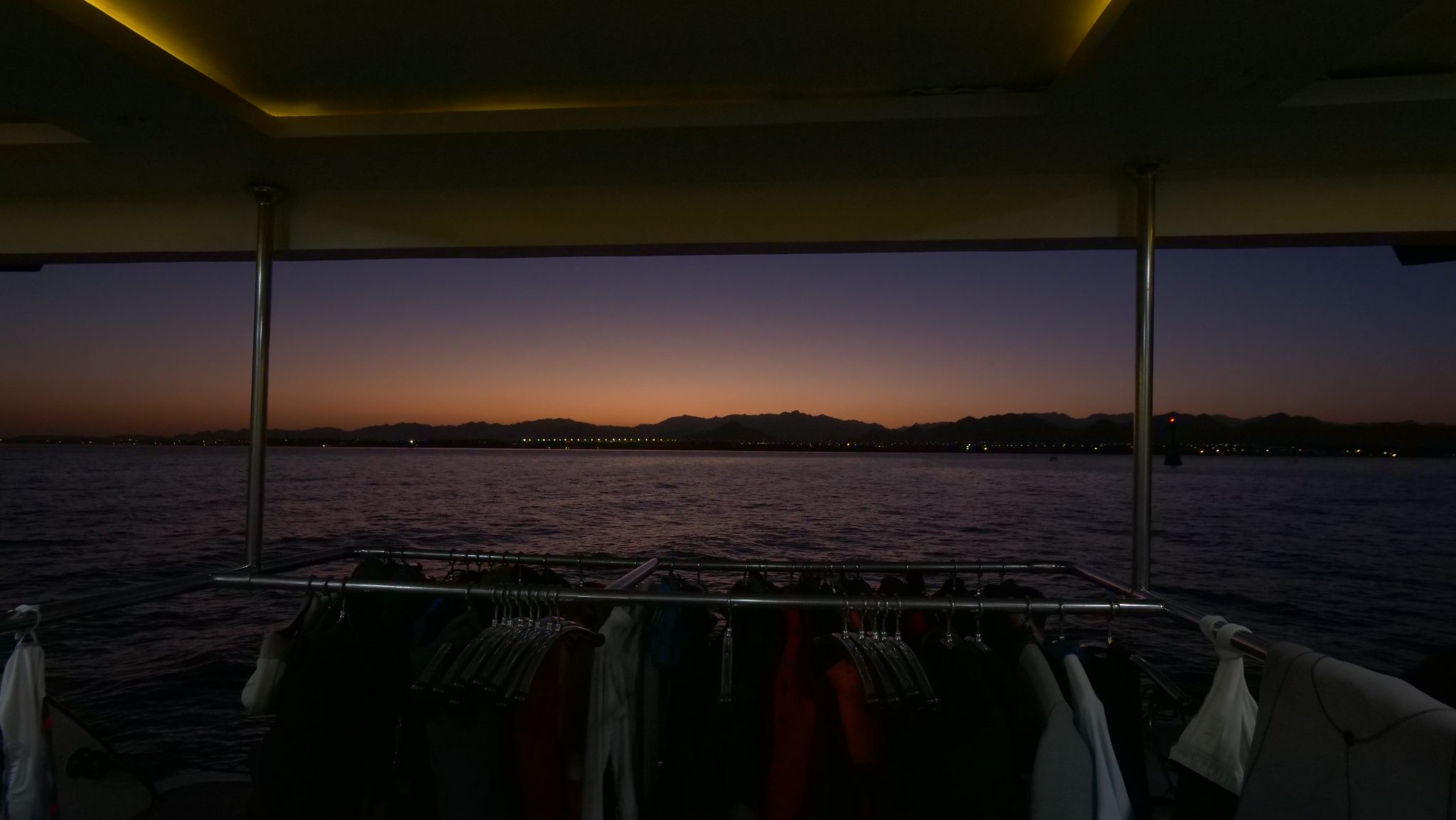
To find out more about the Northern Red Sea reef and wrecks itineraries aboard Ghazala Explorer, or to book, contact Scuba Travel now:
Email: dive@scubatravel.com
Tel: +44 (0)1483 411590
Photos: Jake Davies / Avalon.Red
Blogs
Northern Red Sea Reefs and Wrecks Trip Report, Part 2: Wall to Wall Wrecks
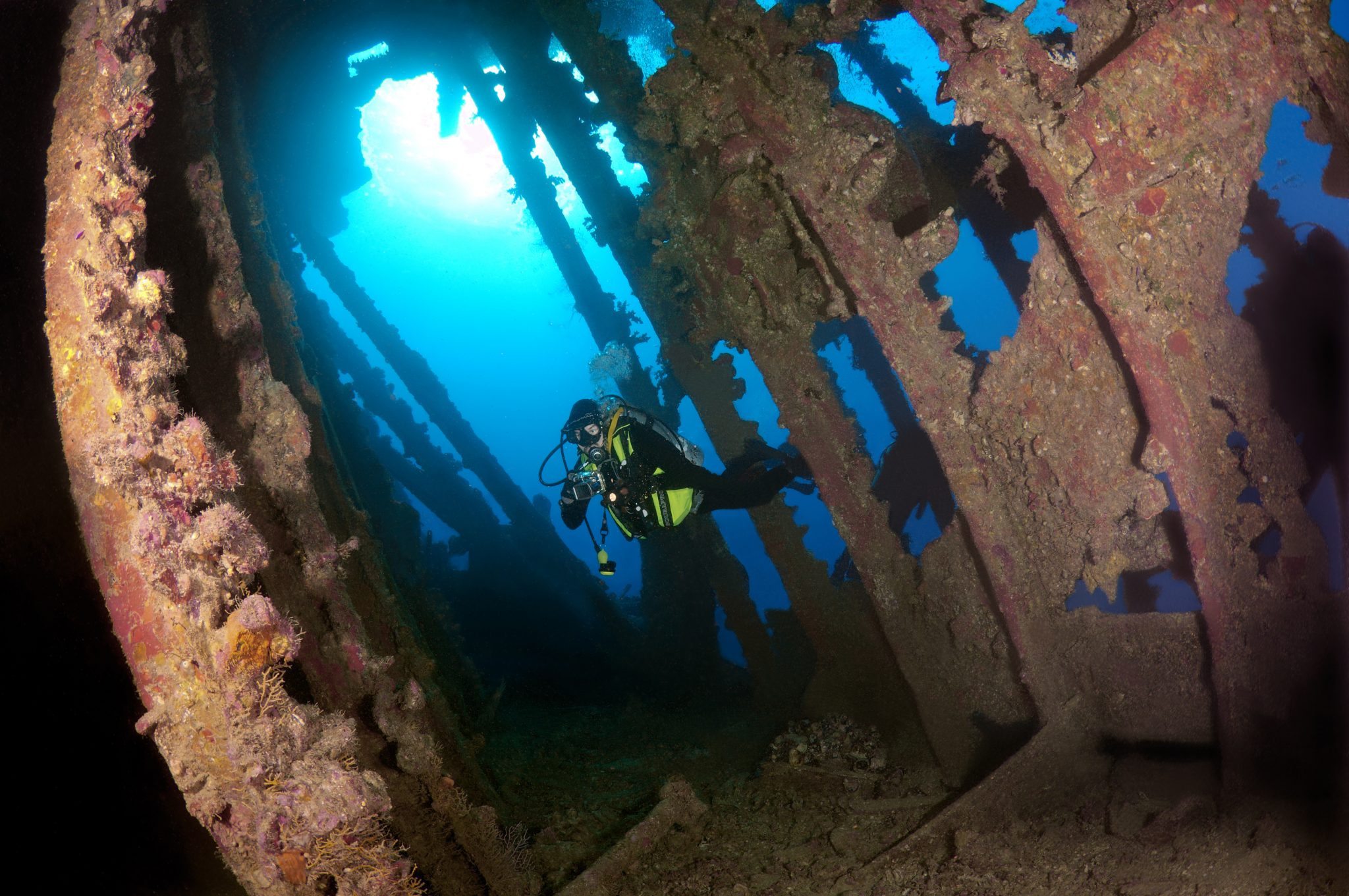
Jake Davies boards Ghazala Explorer for an unforgettable Red Sea diving experience…
The second day’s diving was a day full of wreck diving at Abu Nuhas, which included the Chrisoula K, Carnatic, and Ghiannis D. The first dive of the day was onto the Chrisoula K, also known as the wreck of tiles. The 98m vessel remains largely intact where she was loaded with tiles which can be seen throughout the hold. The stern sits at 26m and the bow just below the surface. One of the highlights of the wreck is heading inside and seeing the workroom where the machinery used for cutting the tiles are perfectly intact. The bow provided some relaxing scenery as the bright sunlight highlighted the colours of the soft coral reef and the many reef fish.
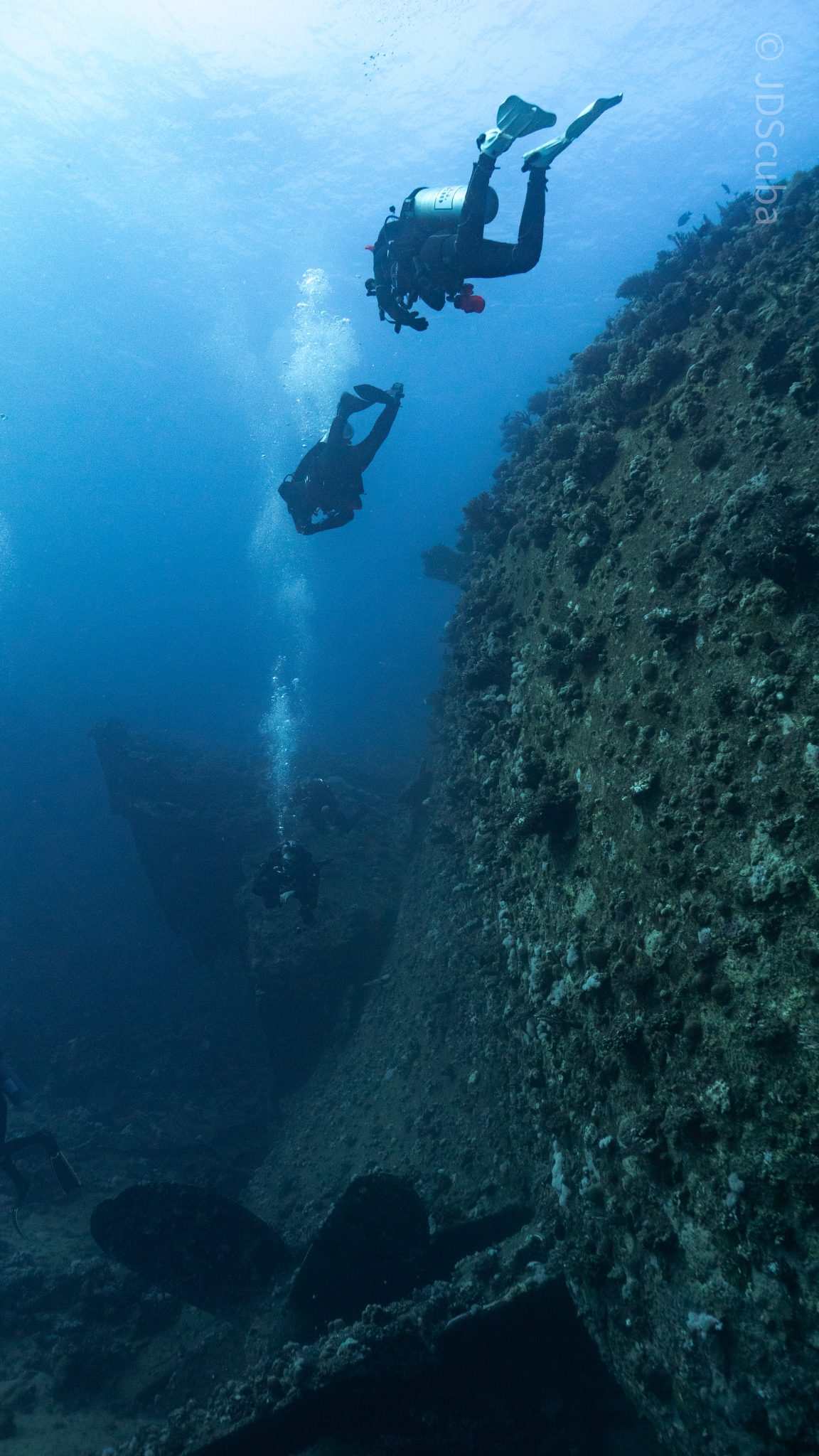
Following breakfast, we then headed to the next wreck, which was the Carnatic. The Carnatic is an 89.9m sail steamer vessel that was built in Britain back in 1862. She ran aground on the reef back in 1869 and remains at 27m. At the time, she was carrying a range of items, including 40,000 sterling in gold. An impressive wreck where much of the superstructure remains, and the two large masts lay on the seafloor. The wooden ribs of the hull provide structures for lots of soft corals, and into the stern section, the light beams through, bouncing off the large shoals of glass fish that can be found using the structure as shelter from the larger predators that are found outside of the wreck.
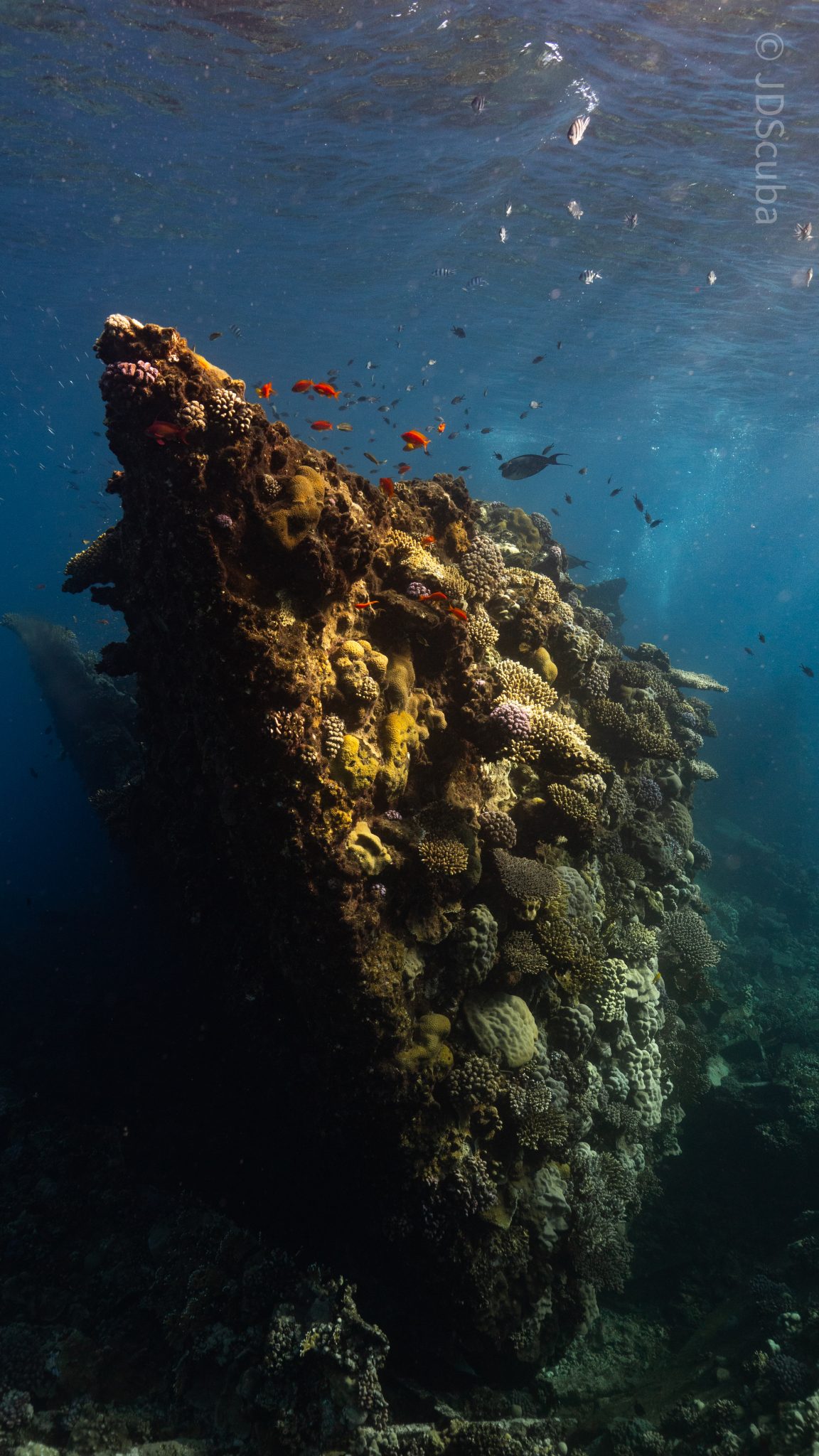
The final wreck at Abu Nuhas was the Ghiannis D, originally called ‘Shoyo Maru,’ which was 99.5m long and built in Japan back in 1969 before becoming a Greek-registered cargo ship in 1980. The ship then ran aground on the reef on April 19th, 1983, and now sits at the bottom at a depth of 27m. Heading down the line, the stern of the ship remains in good condition compared to the rest of the hull. The highlight of the wreck, though, is heading into the stern section and down the flights of stairs to enter the engine room, which remains in good condition and is definitely worth exploring. After exploring the interior section of the ship, we then headed over to see the rest of the superstructure, where it’s particularly interesting to see the large table corals that have grown at the bow relatively quickly considering the date the ship sank. After surfacing and enjoying some afternoon snacks, we made sure everything was strapped down and secured as we would be heading north and crossing the Gulf of Suez, where the winds were still creating plenty of chop.

The next morning, it was a short hop to Ras Mohammed Nature Reserve for the next couple of days of diving. The 6am wake-up call came along with the briefing for the first site we would be diving, which was Shark & Yolanda. The low current conditions allowed us to start the dive at Anemone City, where we would drift along the steep, coral-filled wall. These dives involved drifts, as mooring in Ras Mohammed wasn’t allowed to protect the reefs. As a dive site, Shark & Yolanda is well-known and historically had a lot of sharks, but unfortunately not so many in recent years, especially not so early in the season. However, there was always a chance when looking out into the blue.
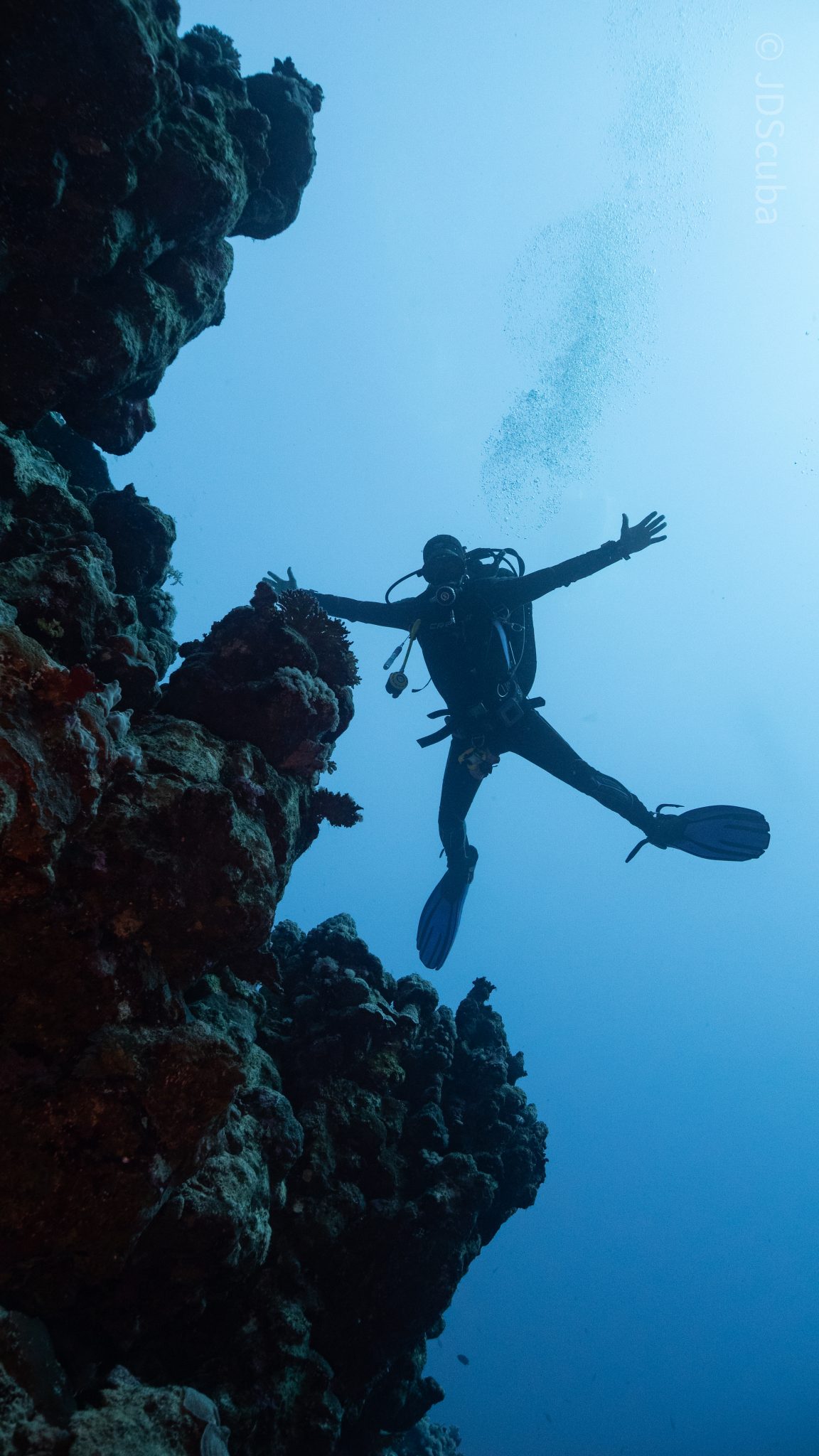
The gentle drift took us along the steep walls of the site, with plenty of anemone fish to be seen and a huge variety of corals. It wasn’t long into the dive before we were accompanied by a hawksbill turtle, who drifted with us between the two atolls before parting ways. Between the two reefs, the shallow patch with parts of coral heads surrounded by sand provided the chance to see a few blue-spotted stingrays that were mainly resting underneath the corals and are always a pleasure to see. With this being the morning dive, the early sunlight lit up the walls, providing tranquil moments. Looking out into the blue, there was very little to be seen, but a small shoal of batfish shimmering underneath the sunlight was a moment to capture as we watched them swim by as they watched us.

Towards the end of the dive, we stopped at the wreck of the Jolanda where the seafloor was scattered with toilets from the containers it was carrying. This provided a unique site to make a safety stop, which was also accompanied by a large barracuda slowly swimming by, along with a hawksbill turtle calmly swimming over the reef as the sun rays danced in the distance.
For the next dive, we headed north to the Strait of Tiran to explore the reefs situated between Tiran Island and Sharm El Sheik, which were named after the British divers who had found them. We started on Jackson before heading to Gordons Reef, where we also did the night dive. All the atolls at these sites provided stunning, bustling coral reefs close to the surface and steep walls to swim along, which always provided the opportunity to keep an eye out for some of the larger species that can be seen in the blue. Midwater around Jackson Reef was filled with red-toothed triggerfish and shoals of banner fish, which at times were so dense that you couldn’t see into the blue. Moments went by peacefully as we enjoyed the slow drift above the reef, watching these shoals swim around under the mid-afternoon sun.
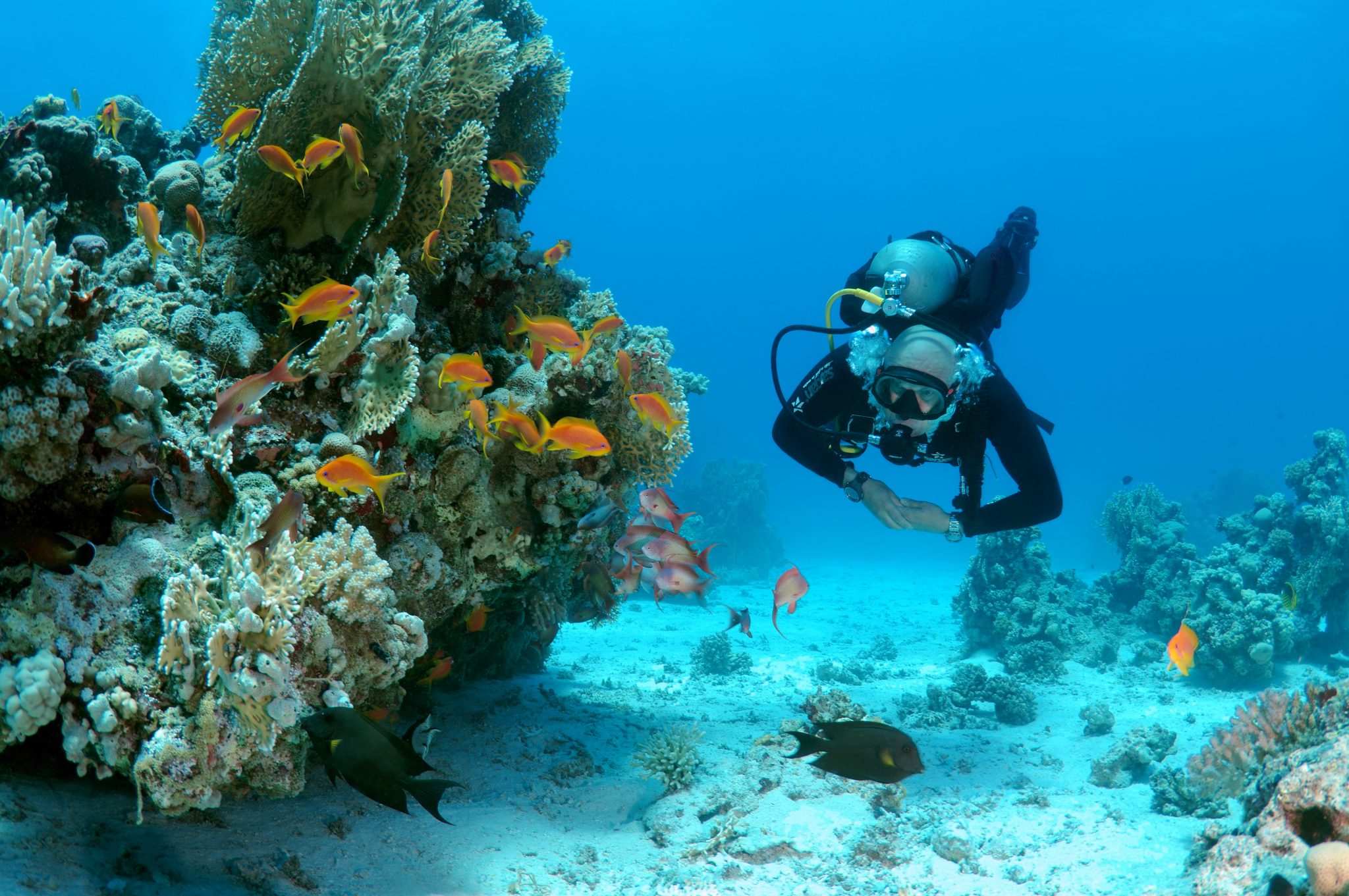
The night dive at Gordon’s Reef was mainly among the stacks of corals surrounded by sand, which was great to explore under the darkness. After some time circling the corals, we came across what we were really hoping to find, and that was an octopus hunting on the reef. We spent the majority of the dive just watching it crawl among the reef, blending into its changing surroundings through changes in colour and skin texture. It’s always so fascinating and captivating to watch these incredibly intelligent animals, in awe of their ability to carry out these physical changes to perfectly blend into the reef. Before we knew it, it was time to head back to the boat to enjoy a well-deserved tasty dinner prepared by the talented chefs onboard.
Check in for the 3rd and final part of this series from Jake tomorrow!
To find out more about the Northern Red Sea reef and wrecks itineraries aboard Ghazala Explorer, or to book, contact Scuba Travel now:
Email: dive@scubatravel.com
Tel: +44 (0)1483 411590
Photos: Jake Davies / Avalon.Red
-

 News3 months ago
News3 months agoHone your underwater photography skills with Alphamarine Photography at Red Sea Diving Safari in March
-

 News3 months ago
News3 months agoCapturing Critters in Lembeh Underwater Photography Workshop 2024: Event Roundup
-

 Marine Life & Conservation Blogs3 months ago
Marine Life & Conservation Blogs3 months agoCreature Feature: Swell Sharks
-

 Blogs2 months ago
Blogs2 months agoMurex Resorts: Passport to Paradise!
-

 Blogs2 months ago
Blogs2 months agoDiver Discovering Whale Skeletons Beneath Ice Judged World’s Best Underwater Photograph
-

 Gear Reviews2 weeks ago
Gear Reviews2 weeks agoGEAR REVIEW – Revolutionising Diving Comfort: The Sharkskin T2 Chillproof Suit
-

 Marine Life & Conservation2 months ago
Marine Life & Conservation2 months agoSave the Manatee Club launches brand new webcams at Silver Springs State Park, Florida
-

 Gear Reviews3 months ago
Gear Reviews3 months agoGear Review: Oceanic+ Dive Housing for iPhone









